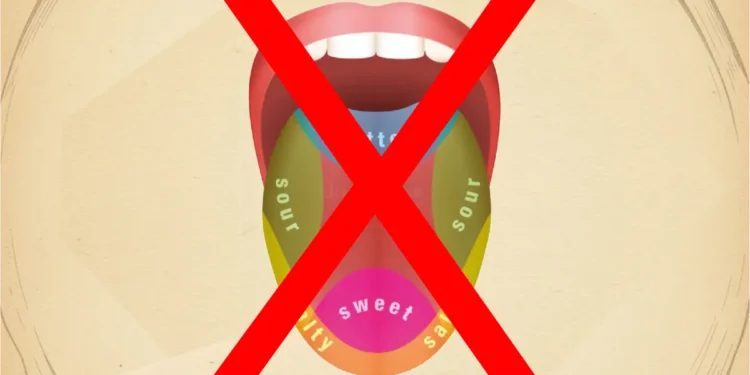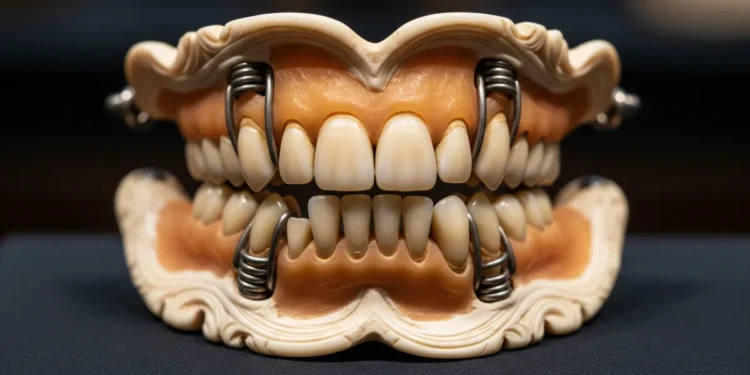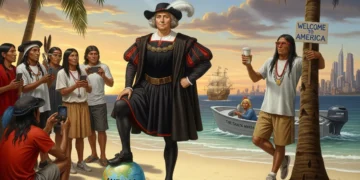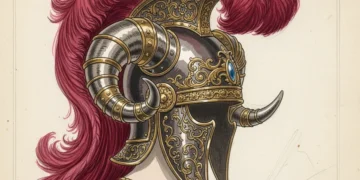A focused investigation into the Tongue Map Myth (the idea that different tongue zones detect distinct tastes), tracing its 19th-century origins, how illustration errors became textbook truth, and why it persists today.
Table of Contents
Introduction
The Tongue Map Myth is perhaps one of the most charming and persistent pieces of scientific misinformation you were ever taught. You can likely picture it now: that neat little diagram from your school science class, with the tip of the tongue reserved for “sweet,” the sides for “sour,” and the back for “bitter.” It’s simple, memorable, and utterly wrong. This seemingly harmless falsehood is not just a quirky piece of trivia; it represents a fascinating case study in how a scientific misinterpretation can be born from a sliver of truth, amplified by a simple drawing, and cemented into public consciousness for over a century.
This article embarks on a focused investigation into every facet of the Tongue Map Myth. We will journey back to its surprising origins in a nuanced 19th-century German dissertation and pinpoint the exact moment a quantitative finding was distorted into a qualitative map. We will explore how a single, powerful illustration in a 1940s textbook launched this falsehood into educational ubiquity, creating a legacy of misunderstanding that was incredibly difficult to correct. The very persistence of the flawed Tongue Map Myth reveals more about our own psychology and the nature of education than it does about our tongues.
Furthermore, we will dissect the definitive scientific rebuttal that unraveled the myth and examine the cognitive biases and cultural inertia that allow it to endure today, even in the face of overwhelming evidence. By exploring the slow process of correcting the record and the broader implications of this textbook error, we will uncover crucial lessons about scientific literacy. This deep dive into the Tongue Map Myth is more than a simple debunking; it is an exploration of how science is communicated, how errors become canon, and why the truth sometimes needs a little help to win out.
The Birth of a Flawed Idea: Early Misinterpretations of Taste Perception
To truly understand the origins of the Tongue Map Myth, we must travel back to the scientific landscape of the late 19th and early 20th centuries. This era was characterized by a fervent desire to measure and quantify human experience, from vision to hearing. Researchers were particularly fascinated with sensory physiology, seeking to map the body’s responses with empirical precision. It was within this environment of psychophysics that the groundwork for the Tongue Map Myth was inadvertently laid. The scientific community was eager to dissect and codify perception, creating a perfect incubator for an idea that simplified the complex reality of taste into an easily digestible, albeit incorrect, diagram.
The central figure in this story is David Hänig, a German scientist whose 1901 dissertation, “Zur Psychophysik des Geschmackssinnes,” became the foundational text for the Tongue Map Myth. Hänig meticulously documented his research, which involved applying taste stimuli (sweet, sour, salty, bitter) to different regions of volunteers’ tongues. His findings were nuanced; he noted that while all tastes could be perceived across the entire tongue, certain areas showed slightly lower detection thresholds for specific tastes. For instance, the tip of the tongue might be marginally more sensitive to sweetness, but it could still detect bitterness, saltiness, and sourness perfectly well.
Here lies the critical point of divergence. Hänig’s work was purely quantitative, showing subtle variations in relative sensitivity, not exclusive zones of taste. However, his data, when visualized, produced a graph with peaks and valleys corresponding to these minor differences. It was the subsequent misinterpretation of this graph that birthed the Tongue Map Myth. The slight dips in sensitivity were exaggerated into an inability to taste, and the peaks were transformed into absolute, specialized regions. This flawed reading of complex data created a simplified, qualitative “map” that was far from what Hänig had actually discovered, planting the seeds for the enduring Tongue Map Myth.
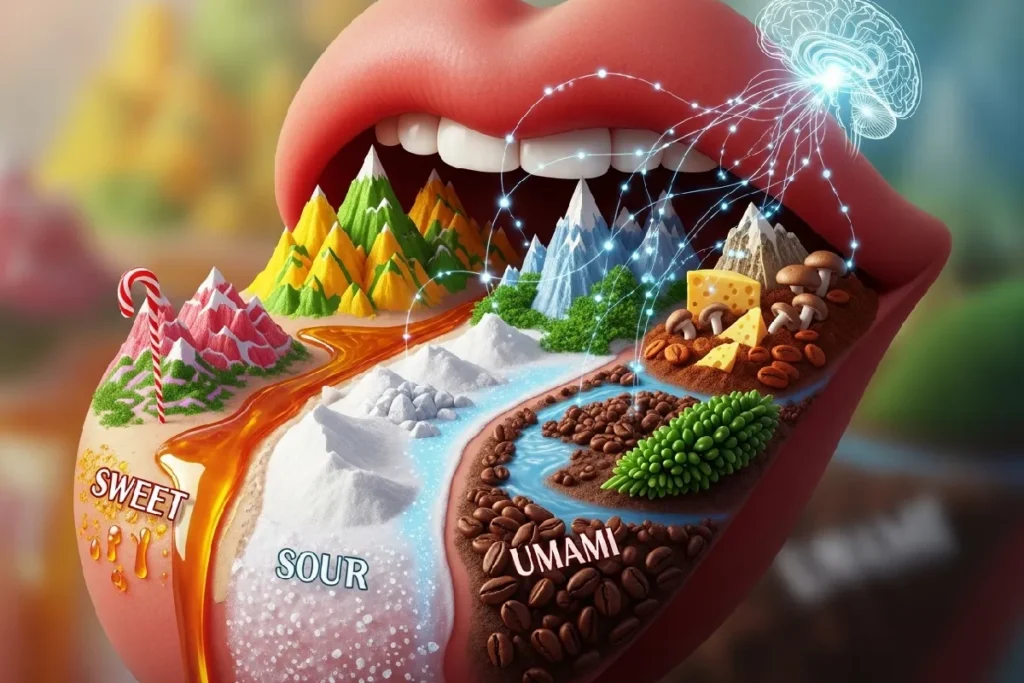
The Illustrative Leap: How a Sketch Became Textbook Truth
The power of a compelling diagram in science education cannot be overstated. Visual aids can distill complex information into understandable formats, making abstract concepts concrete for students. However, this simplification carries a significant risk: oversimplification can lead to outright distortion. In the mid-20th century, as textbooks increasingly relied on illustrations to convey scientific principles, the stage was set for a misunderstanding to become canon. The journey of the Tongue Map Myth from obscure data to classroom staple is a perfect case study in how a picture, intended to clarify, can instead cement a falsehood for generations.
The pivotal moment for the Tongue Map Myth arrived in 1942. Harvard psychologist Edwin G. Boring, in his highly influential textbook Sensation and Perception in the History of Experimental Psychology, reproduced a diagram based on the misinterpreted Hänig data. Boring’s goal was likely pedagogical—to provide a clear, simple visual for his readers. Instead, he created a simplified, zonal illustration that visually codified the falsehood. His book’s academic authority lent the flawed Tongue Map Myth a legitimacy it never deserved, effectively launching it from a niche misinterpretation into the educational mainstream.
Why did this particular image stick so stubbornly in our collective consciousness? The answer lies in its deceptive simplicity. The Tongue Map Myth presents a neatly compartmentalized, easily memorized chart that appeals to our innate desire for order and clarity. The concept of having a specific “sweet spot” or “sour zone” is far more intuitive and digestible than the complex reality of thousands of taste buds working in concert across the entire tongue. This visual elegance and mnemonic quality made the Tongue Map Myth a teacher’s favorite and a student’s easy answer, ensuring its self-perpetuating journey through decades of science education.
The Scientific Rebuttal: Unraveling the Tongue Map Myth’s Biological Reality
Modern gustatory science paints a far more intricate and fascinating picture of taste than the one suggested by the Tongue Map Myth. Our ability to taste originates from taste buds, which are clusters of receptor cells housed within small bumps on the tongue called papillae. Critically, these taste buds are not segregated by function. While their density varies, they are distributed across all regions of the tongue—the tip, the sides, and the back. Each of these taste buds contains cells capable of detecting all five primary tastes: sweet, sour, salty, bitter, and umami. This fundamental reality of our anatomy directly refutes the zonal concept at the heart of the Tongue Map Myth.
The definitive scientific takedown of the Tongue Map Myth came in 1974, when researcher Virginia Collings revisited the topic. She meticulously re-examined Hänig’s original premise and conducted her own, more sensitive tests. Her findings confirmed what Hänig’s data had subtly suggested all along: while minor variations in sensitivity can exist across the tongue, all tastes can be detected wherever there are taste buds. Her work left no room for ambiguity, demonstrating that there are no distinct, isolated zones for different tastes. This research should have been the final nail in the coffin for the flawed Tongue Map Myth.
Further advancements in neuroscience and molecular biology have only reinforced this conclusion, completely dismantling the Tongue-Map-Myth. Scientists have now identified the specific receptor proteins on taste cells that bind to molecules in our food, initiating the sensation of taste. This research has shown that individual taste buds contain cells with receptors for various tastes, all functioning in close proximity. This complex, integrated system sends a holistic signal to the brain, a far cry from the simplistic, compartmentalized model the Tongue Map Myth proposes. The myth was not just a simplification; it was a fundamental misrepresentation of our sensory biology.
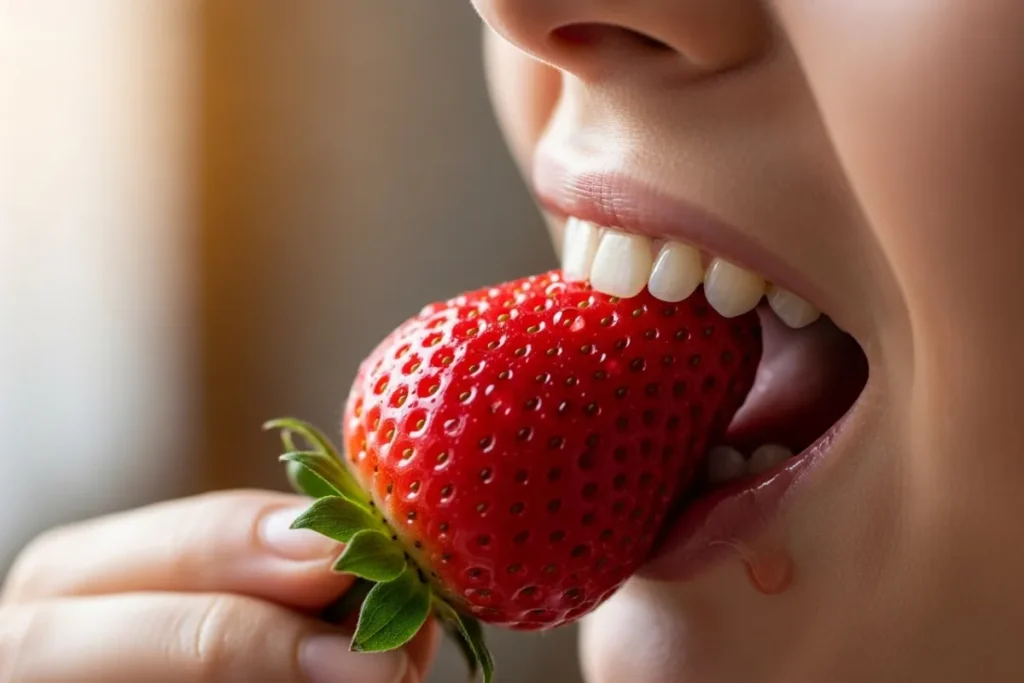
The Persistence Problem: Why Does the Tongue Map Myth Endure?
If the Tongue Map Myth was scientifically dismantled decades ago, why does it remain so stubbornly lodged in our collective memory? The answer lies less in biology and more in the quirks of human psychology. Cognitive biases play a significant role in its survival. The availability heuristic, for instance, means we tend to rely on information that is easily recalled.
A simple, colorful diagram of taste zones is far more memorable and mentally “available” than a complex explanation of gustatory receptor cells. This is compounded by confirmation bias; if we happen to notice the sweetness of ice cream on the tip of our tongue, our brain might register it as a confirmation of the flawed Tongue Map Myth, while ignoring all contradictory evidence.
Beyond individual psychology, the Tongue Map Myth benefits from a powerful cultural inertia. Once an idea becomes deeply embedded in educational materials, it develops a life of its own. For decades, it was a staple in science textbooks, lesson plans, and classroom posters. Generations of students were taught this myth as fact, and many of them went on to become teachers, parents, and writers themselves, unwittingly perpetuating the falsehood. Correcting such a widespread misconception is not as simple as publishing a new study; it requires actively un-teaching a concept that has become an accepted piece of common knowledge, a far more challenging task.
This cycle is reinforced by the continued appearance of the Tongue Map Myth in informal and popular culture. You can still find it referenced in wine-tasting guides that speak of tasting tannins on a specific part of the tongue, on children’s educational websites, and even in marketing materials for food products. Every time this anachronistic diagram is shared, it gains a renewed sense of legitimacy, creating a feedback loop that keeps the myth alive. The persistence of the Tongue Map Myth is a powerful reminder that in the battle for public understanding, the simplest and most visually appealing idea often has an advantage over the complex truth.
Education’s Catch-Up: Correcting the Record on the Tongue Map Myth
The process of correcting an entrenched scientific falsehood within the formal education system is often frustratingly slow, and the Tongue Map Myth is a prime example. For decades after it was scientifically debunked, textbooks continued to be published with the same erroneous diagram. The lifecycle of educational publishing is long, and the perceived “harmlessness” of the myth meant there was little urgency to revise it. School districts adopt curricula for years at a time, and teachers often rely on lesson plans they have used for their entire careers. This institutional inertia allowed the consequences of the Tongue Map Myth to linger in classrooms long after they were purged from scientific literature.
In the face of this slow institutional change, the role of individual educators and science communicators has become absolutely vital. Proactive teachers who stay current with scientific understanding are on the front lines, actively debunking the Tongue Map Myth for their students and explaining why it was once believed. Beyond the classroom, science communicators—from museum curators and YouTubers to bloggers and authors—have taken up the cause. They can operate outside the constraints of formal curricula, directly addressing the public and providing engaging, accurate explanations that dismantle the flawed Tongue Map Myth with modern evidence.
Fortunately, these efforts are bearing fruit. Many modern biology textbooks now explicitly introduce the tongue map as a historical misconception, using it as a teachable moment about how science corrects itself. Science museums have created interactive exhibits that allow visitors to test their own tongues, personally discovering the falsehood of the Tongue Map Myth. These successful initiatives demonstrate a shift in educational strategy: instead of simply ignoring the myth, they confront it head-on, turning a persistent piece of misinformation into a powerful lesson on scientific literacy and critical thinking. Rethinking the Tongue Map Myth in this way strengthens, rather than undermines, science education.
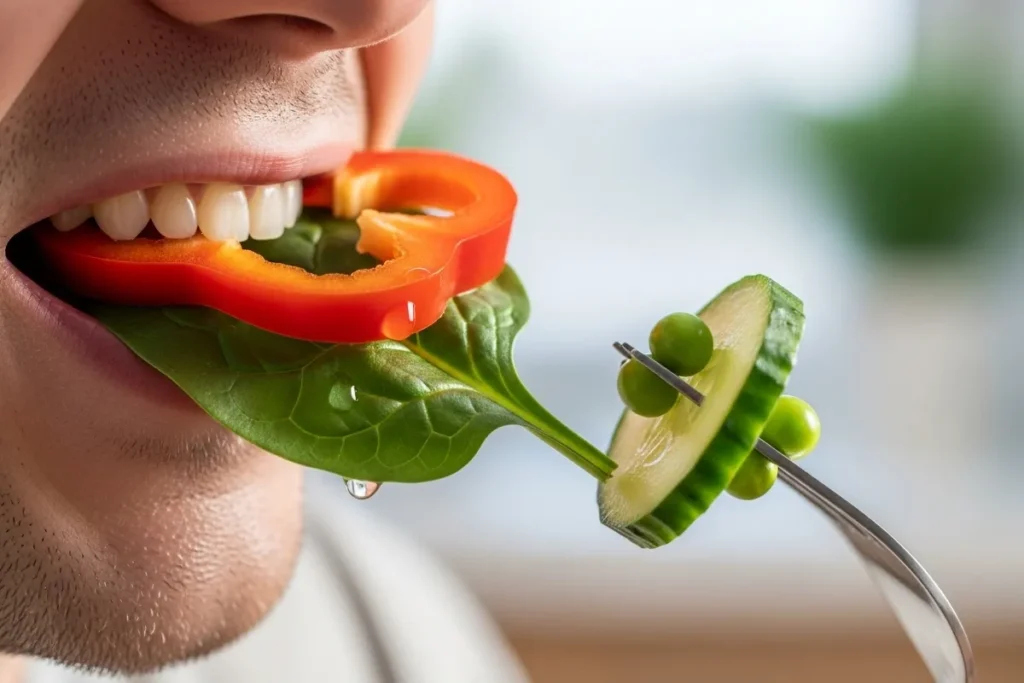
Beyond the Tongue: Broader Implications of the Tongue Map Myth’s Legacy
The story of the Tongue Map Myth is not an isolated incident; it serves as a powerful archetype for how scientific misinformation takes root and persists. Its legacy is visible in other widely held misconceptions, such as the idea of distinct “learning styles” (visual, auditory, kinesthetic) or the myth that people are either “left-brained” (analytical) or “right-brained” (creative). Much like the Tongue Map Myth, these ideas stem from a kernel of scientific truth that is then grossly oversimplified and packaged into a neat, appealing, but ultimately false, dichotomy. They are popular not because they are accurate, but because they offer simple labels for complex human processes.
Understanding the historical trajectory of the Tongue Map Myth provides crucial lessons for improving science education and public outreach today. It underscores the profound responsibility of educators and communicators to prioritize accuracy over simplistic appeal. A compelling diagram is a powerful tool, but when it distorts the truth, it becomes a detriment to learning. The primary goal of science education should not be mere memorization of facts, but fostering an appreciation for the scientific process itself—a process defined by curiosity, nuance, and a constant willingness to revise our understanding in the face of new evidence. The flawed Tongue Map Myth becomes a perfect case study for this very principle.
The consequences of the Tongue Map Myth extend beyond a simple misunderstanding of taste. When such a fundamental “fact” taught in school is later revealed to be false, it can foster a subtle cynicism toward science as a whole. It can make scientific knowledge seem arbitrary and untrustworthy, eroding public confidence. Furthermore, it promotes a shallow level of scientific literacy, encouraging people to accept simple, compartmentalized explanations rather than engaging with the beautiful complexity of biological systems. The enduring legacy of the Tongue Map Myth is therefore a critical reminder of the importance of vigilance and accuracy in the ongoing effort to build a scientifically literate society.
Rethinking Taste: The Future of Sensory Education
Moving beyond the debunked Tongue Map Myth allows us to embrace a much more dynamic and accurate understanding of taste. Current research emphasizes that flavor is a multisensory experience, a symphony conducted by the brain. The sensation we call “taste” is not confined to the tongue; it is an intricate fusion of gustation (the five basic tastes), olfaction (the aroma of food traveling up the back of the throat to the nasal passages), and chemesthesis (the physical sensations of texture, temperature, and even the “heat” from chili peppers). This holistic concept of flavor perception is where the future of sensory education lies.
To truly educate about taste, we must develop more engaging and accurate teaching methods that leave the flawed Tongue Map Myth in the past. Instead of showing a static, incorrect diagram, educators can use simple, interactive experiments. For example, having students taste a piece of fruit while holding their nose, and then again while breathing normally, powerfully demonstrates the critical role of smell in creating flavor. This hands-on approach is not only more memorable but also instills a more sophisticated and accurate model of sensory physiology, moving far beyond the simplistic limitations of the Tongue Map Myth.
Ultimately, the complete deconstruction of the Tongue Map Myth serves a higher purpose. It is a call to action for a more vigilant and dynamic approach to scientific literacy. We must encourage continuous critical evaluation of the information we consume, questioning its origins and evidence. The goal is not just to correct a single falsehood but to foster a public that appreciates science as a constantly evolving process of discovery, not a collection of immutable facts. By retiring persistent misconceptions like the Tongue Map Myth, we make way for a deeper, more accurate, and far more wondrous appreciation of the world around us.

Conclusion
From its accidental birth in a misread German dissertation to its century-long reign in science classrooms, the journey of the Tongue Map Myth is a testament to the power of a simple, compelling falsehood. We have traced its origins from nuanced quantitative data to a flawed qualitative diagram, pinpointing how a single illustration codified this error for generations. We have also examined the definitive scientific evidence that dismantled the myth, revealing a far more complex and integrated reality of taste perception, where all tastes are detected across the entire tongue. The history of this myth is a clear narrative of error, propagation, and eventual correction.
The central lesson from the persistence of the Tongue Map Myth is not about the biology of taste, but about the psychology of learning and the mechanics of misinformation. The myth survived for so long not because the science was ambiguous, but because the erroneous diagram was intuitive, easy to teach, and visually appealing. Its story serves as a stark reminder that in the ecosystem of ideas, simplicity and memorability can grant a falsehood a longer life than a complex truth. The flawed Tongue Map Myth highlights a critical vulnerability in how we communicate and absorb scientific knowledge.
Therefore, the legacy of the Tongue Map Myth should be a call to action for educators, communicators, and curious readers alike. It urges us to champion a more robust form of scientific literacy—one that prioritizes critical thinking over rote memorization and embraces nuance over deceptive simplicity. By using this myth as a teachable moment, we can foster a healthier skepticism and a deeper appreciation for the scientific process itself. Let us commit to not only debunking such myths but also to building an educational foundation that is resilient to the next compelling falsehood that comes along.
